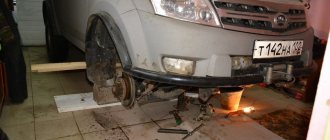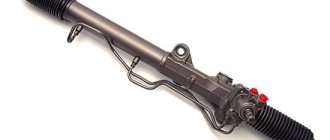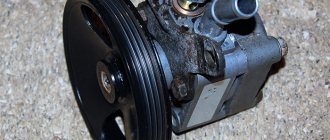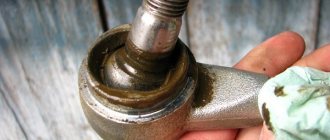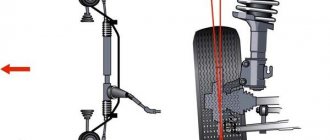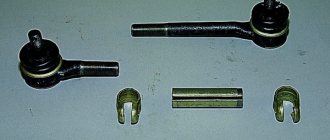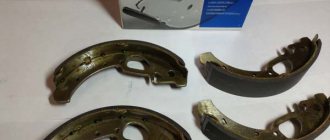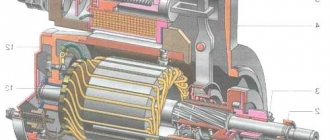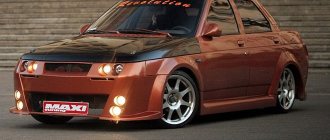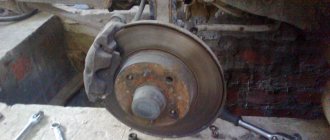Just a reminder. I write exclusively my own opinion and do not pretend to be complete. The task is simple for everyone to understand.
Let's figure it out in order. 1. Standard steering wheel lock.
Met.
a pin that “moves out” when we remove the key from the ignition. In fact, it's nothing.
Breaks when kicked on the steering wheel.
2. Poker on the steering wheel, “locker” on the pedal.
In fact, this is nothing
. The steering wheel bends or simply snaps. Because The steering wheel is a hoop that is not very thick. The pedals simply bend back. You can even remove it completely.
3. Blocker at the checkpoint
.
With or without pin with internal pin. In fact, it's nothing.
The gearshift lever moves one or two cables. These cables fit the box and resp. move the selectors. Even if you block the lever, it is quite easy to remove the rods from the lever or from the selector. And move the selector by hand. Usually, you just need to go to a septic tank or a neighboring yard. And then we’ll have to figure it out...
4. Steering shaft lock
.
Like "Guarantor". A clutch is attached to the steering shaft. Which constantly rotates with the shaft. There are guides on the coupling. A metal wedge is pushed into these guides “by touch” and is fixed on the coupling. Thus, the steering shaft is blocked. To remove the pin, you also need to insert the key by touch into the cylinder on the pin. Both manipulations are quite inconvenient. Gradually you get used to it. For girls, it is usually quite inconvenient. Removing it during theft is quite a hassle. I recommend it to enhance the anti-theft properties of a car
. Available for self. installations. Recommendations:1. When installing, use coarse sandpaper to “lift” the surface on the steering shaft for good fixation. 2. Leave the car with the wheels turned to the side and so blocked.3. If the coupling is not tightened sufficiently, the coupling may “scroll” on the shaft. We need to make sure it's a good fit.
5. Hood lock. Laughter. drive or electric drive.
The hood lock itself is not an anti-theft device.
It enhances signaling properties. because Usually there is at least one “blocking” of the engine - hidden under the hood. 5.1 Hood lock with mechanical drive. There will be a cylinder and a key for unlocking in the interior. Usually this is how the standard hood lock is blocked. With assistant add. cable - the standard hood lock is held in place. And without a key, you can’t pull the usual lever and open the hood. In practice, it quickly becomes loose in connections. Stretching. I do not recommend this option. 5.2 Hood lock - electrically driven. Has a common noun. Defen-time. It is a “electrically driven latch.” There is metal on the hood. loop or ball. And in the opposite part there is a pin, which, with the help of a cable, moves back and forth with an electric motor. Drive - usually connected to the signaling system. When disarmed, the hood unlocks. When arming, the hood is locked. The logic is that if, WITHOUT disarming, you pull the hood lever, the hood will not open (under the hood there is a siren that cannot be quickly broken. Under the hood there are electronic engine locks, access to which is locked along with the hood. I recommend installation in tandem with the signaling. But with the conditions for “correct” installation:
There are several important points. 1. If the signaling has been “opened” by electronic hacking, then with a “normal” connection the hood will naturally open. 2. Usually, if you pull behind the hood lever when the Defen-Time is locked, the hood will open slightly. You can saw through the pin. 3. Since the “latch” is in the front, dirt gradually gets clogged and can turn sour. Regular WD40 lubrication is required. 4. If the battery runs out, then the hood - will remain locked. Without special skills, it will be difficult to open. Be sure to have a safety cable, which during normal installation is hidden in the cabin. By pulling it, you can mechanically open the lock.
For good implementation of protection, it would be good to install Defentime taking into account the trace. points: 1. Install TWO locks at the corners of the hood. 2. Anti-spray protection (metal well, tube on pin). 3. Implement the connection for example like this. When disarmed with the key fob, the locks DO NOT open. When the ignition is turned on and the additional immobilizer tag is recognized, the locks open. Step-by-step protection. This is how we protect ourselves from key theft in Auchan. But on the condition that we carry the immobilizer tag separately from the keys. 4. Safety cable - do not extend inside the cabin. Stock up on specials. wires to open the lock when the battery is dead.
6. Armor on ECU
. Jokes aside, Blocks are often stolen due to their high cost. It consists of a metal semi-housing that covers the ECU unit and is screwed to the body with shear bolts. If at the same time you block the chip on the block, you will not be able to use the “spider” you brought - another set of wiring for starting in case of theft. The thing is quite exotic.
7. Gear-lock.
Quite effective blocking.
“looks like Defentime. Also an “electrically driven pin”. Only it is not the hood that is blocked, but the gear selector - directly on the box. The entire mechanism is located under the hood, on the gearbox. If at the same time a hood lock is installed, then all together it will be serious protection. I recommend
. Like defentime, a lot depends on the signal. If the signaling is bullshit and is easily opened by an “electronic oGarant”). At the same time, the larva also changes. For foreign cars - not applicable. It's a pity. You can't break this one with your foot.
Purpose of the steering shaft lock
When activated, the device fixes the steering column shaft in a certain position, completely eliminating its rotation or leaving the possibility of rotation by several degrees.
Steering wheel lock designs
Lockers are made for each specific car model or steering column.
Today, there are several designs of steering shaft locks on the market:
- Pin mechanical lock. The basis of the device is a coupling housing made of carbon steel, which is installed on the steering shaft in the area of the pedal assembly. The housing has a hole into which the locking rod is inserted and secured with a lock. To remove the lock, you need to insert the key into the lock, open it and pull the pin out. One of the most common devices of this type is the Garant blocker, which is produced by the Russian company. Can be used as a regular key with a bit, which is inserted into the hole. and the original disk key with recesses.
- Pinless devices, structurally similar to speed shift drive locks on gearboxes. The shaft is blocked by a retractable bolt device with a diameter of about 10 mm, made of high-strength steel. The advantage of such blockers is their invisibility, since in the space near the driver’s feet there is only a small keyhole. An example of such a device is the Garant Fort. The operation of such a device is simpler than a pin one, since simply turning the key in one direction or the other is enough to lock and release the shaft. At the same time, the design has a special fuse that prevents spontaneous locking of the shaft.
- Electromechanical interlocks installed in place of the standard ignition switch. The category of such devices includes “Garant Bastion”.
Removing the steering column from a car
VAZ 2110 steering cardan
To replace the driveshaft, you need to remove the steering column from the car. Begin:
- de-energize the battery;
- after that, remove the cover of the signal switch on the steering wheel (to do this, pry it off with a screwdriver);
- remove the cover from the steering wheel;
- Now we are faced with two self-tapping screws, which should be unscrewed with a curly screwdriver;
- after this the lid is completely removed;
Removing the steering wheel cover
- now you need to use the same figured screwdriver to unscrew the three screws that secure the contact of the sound signal;
- disconnect the wire and remove the contact;
- now you will need to take the key for 24;
- use it to unscrew the nut that secures the steering wheel (this should not be done completely, leaving the nut mounted on the shaft);
- remove the steering wheel by pulling it towards you.
Removing the steering wheel
- dismantle the steering column switch assembly;
- We also remove the ignition switch;
- take a 13mm wrench and unscrew the bolt securing the elastic coupling (located under the pedals);
- Unscrew the bolts securing the steering shaft at the front.
- now unscrew the nuts securing the steering at the rear, using a 13mm wrench;
- dismantle the steering column of the VAZ.
Which one is better to choose?
Each product has its own disadvantages and advantages, but all devices cope well with their main task. They make it more difficult to steal a car and increase the time it takes. The most common models and reviews about them are listed below.
Blockers "Block Lux" and "Garant CL"
produces several series of pin blockers:
- “Block Lux” model, designed for various models of imported and domestic cars;
- model “Garant CL”, specially created for inexpensive domestically produced cars.
- Both models are highly resistant to burglary (according to factory documentation, the average burglary time is 1800 seconds).
- The use of imported larvae with a number of combinations of at least 350 million units reduces the risk of selecting a key to zero.
- A large assortment suitable for all models common on the Russian market.
- At the end of the clamp there is a cover made of elastic PVC, which allows you to comfortably use the product at low negative temperatures.
- According to tests in automotive publications, the product can only be opened by cutting it with an electric tool or turning the lock cylinder with a special master key.
- The cost of locks is up to 10 thousand rubles, installation services under service conditions will cost another 1.5...2 thousand rubles.
- According to reviews from owners, such a blocker is best used in conjunction with an electronic alarm system, while the “Garant” is a bigger problem for car thieves.
- When opening such blockers, a piece of pin is most often used in a certain place.
- There have been cases of loosening of the coupling on the shaft of machines with hydraulic booster.
- To facilitate turning, motor oil or grease is added to the gap between the surface of the coupling and the shaft.
- There have been cases of attackers removing a section of the steering shaft along with the lock. But such cases are rare, and Garant products fully cope with the responsibilities assigned to them.
For additional protection of the lock, a protective case (shell) is available, made of 20X steel with a wall thickness of up to 5 mm. The product is installed on the surface of the coupling and is pressed when installing the rod. The case has a surface treatment (nitriding and carburization), due to which it has increased hardness (up to HRC 60), which increases the resistance of the lock to cutting with an electric tool. The average cost of a shell is 2.5 thousand rubles.
Blocker brand "Intercept Universal"
One of the main competitors to Garant locks is the Intercept Universal mechanical lock produced by LLC Protection Systems+. It can be installed on any cars.
Basic product data:
- A big advantage of the design is the shaft grip area of the stopper.
- The design of the product uses grade 45 steel and stainless steel, which increases the strength of the product.
- The ring key has at least 1 million combinations.
- According to tests conducted by automotive publications, opening the Intercept Station Wagon does not take much time. The device is opened with a gas self-clamping key and a lever made of a pipe of a suitable diameter.
- The average cost of the device is about 8 thousand rubles.
The video of the perehvatsz channel demonstrates the appearance and characteristics of the Intercept Universal device.
Blockers "Grand Security"
Less common are blockers under the Grand Security brand.
The advantages of the blocker include:
- The device pin is made of 40X steel and is equipped with a reliable Solex locking mechanism.
- Installation in confined spaces makes it difficult to use mechanical cutting tools.
- In the closed position, the pin overlaps the heads of the screws that secure the housing coupling. The screws themselves are located in recesses, so they are not accessible from the sides.
- The body is made of steel, then hardened to a hardness of at least HRC 45, which makes drilling and cutting difficult.
- The use of a double-sided stopper makes it difficult to break into the product.
- The design of the coupling uses rotating elements that make it difficult to hold the pin when drilling out the lock cylinder.
- Selecting a key is complicated by a large number of combinations (according to the documentation - at least 300 thousand options).
Alarm set "Grand Security"
When testing the locks, the Grand products were opened by removing the lock cylinder. The cost of the product is about 3-4 thousand rubles, and installation - no more than 1.5 thousand rubles.
Blockers "Fortus"
In addition to the listed models, there are Fortus CLS locks on the market, which have a similar design and price.
Fortus products are characterized by:
- The use of high-alloy steels and carbide inserts in the cylinder design, which complicate the drilling procedure.
- The springs in the lock design are made of bronze and are not subject to acid etching.
- The key design has a floating pin, which further complicates the opening procedure using master keys.
- The product has a dust and dirt protection system, which ensures a long product life.
- If the key is lost, it can be restored in a specialized workshop. To do this, each lock set contains a card with a code that is used to select a key.
Types of steering mechanisms
The design of the steering mechanism varies depending on the method of torque conversion. According to this parameter, worm and rack types of mechanisms are distinguished. There is also a screw type, the operating principle of which is similar to a worm gear, but it has greater efficiency and realizes greater force.
Worm steering mechanism: device, operating principle, advantages and disadvantages
This steering mechanism is one of the "obsolete" devices. Almost all models of domestic “classics” are equipped with it. The mechanism is used on off-road vehicles with dependent suspension of the steered wheels, as well as in light trucks and buses.
Worm gear diagram
Structurally, the device consists of the following elements:
- steering shaft;
- worm-roller transmission;
- crankcase;
- steering bipod.
The worm-roller pair is in constant engagement. The globe worm is the lower part of the steering shaft, and the roller is attached to the bipod shaft. When the steering wheel rotates, the roller moves along the teeth of the worm, due to which the steering bipod shaft also rotates. The result of this interaction is the transmission of translational movements to the drive and wheels.
The worm type steering mechanism has the following advantages:
- the ability to turn the wheels to a larger angle;
- shock absorption from road irregularities;
- transmission of great forces;
- ensuring better maneuverability of the machine.
Manufacturing the structure is quite complex and expensive - this is its main disadvantage. Steering with such a mechanism consists of many connections, periodic adjustment of which is simply necessary. Otherwise, you will have to replace damaged elements.
Rack and pinion steering mechanism: device, principle of operation, advantages and disadvantages
The rack and pinion steering mechanism is considered more modern and convenient. Unlike the previous unit, this device is applicable on vehicles with independent steering wheel suspension.
How to install?
Installation of pin blockers does not require special tools and can be done with your own hands.
For installation you may need:
- hex keys;
- socket heads;
- screwdrivers with flat and Phillips blades;
- torque wrench (if available);
- coarse sandpaper.
The installation diagram for a blocker such as “Garant Block”, “Grand” or “Intercept Universal” is as follows:
- Remove the ignition key from the lock and secure the steering shaft with the standard lock located in the lock.
- Remove the steering column protective cover.
- Install the housing parts on the steering shaft in the free space between the brake and clutch pedals. The installation location must provide unimpeded installation and removal of the locking rod. Before installation, the surface of the shaft is cleaned with coarse sandpaper, which improves contact between surfaces.
- Pre-tighten the screws to a torque of up to 25 N/m (tightening torques may vary and are indicated in the product instructions).
- Unlock the shaft from the standard lock by inserting the key into the ignition switch.
- Turn the steering wheel from lock to lock and make sure that the blocker body does not touch the elements of the steering column, pedal assembly, etc. Check that the electrical wiring elements are not located near the clutch. Wires should be located as far away from the device as possible.
- Secure the coupling body by tightening the screws to a torque of 40 N/m and insert the locking pin into it.
- A correctly mounted pin lock will allow you to rotate the steering wheel by 10...20 degrees. Rotation is limited by the pin resting on the body elements or steering column.
The blocker setup looks like this:
- Turn off the alarm, open the door and sit in the driver's seat.
- Insert the key into the lock and turn it clockwise until it stops (for most products).
- Remove the stopper from the clutch body, turn the key back and remove it from the lock.
To lock, the pin is inserted into the hole in the coupling and automatically snaps into place.
Pinless blockers are installed using a similar algorithm.
For example, installation of the Garant Fort product looks like this:
- Install a coupling on the shaft that should not interfere with free rotation. The design of the coupling has a groove and a bolt that blocks the shaft from turning.
- Mount a flexible drive that connects the lock cylinder and the bolt drive. (The drive is located in a thick-walled steel pipe.) Place the keyhole on the lower decorative cover of the instrument panel under the steering column.
- Install standard protective screens from the kit, which protect the lock structure from breaking.
How it works
One of the important elements of the vehicle is the steering mechanism, as well as the drive of the same name. An important part of this system is the steering bipod. This is a part with which the middle rod (trapezoid) is attached to the gearbox. The bipod is also called the connecting rod. Its role is to carry out reciprocating rotation, which depends on similar actions of the steering shaft.
This part is usually used in cars with a conventional steering control system and suspensions equipped with transverse parallelogram rods. This steering option is used today in many rear-wheel drive cars (for example, VAZ), as well as in most light trucks.
The design of the described part contains a splined lever. It connects to the bearing (with its threaded rod), seat and steering mechanism. Also in this system, a special role is played by the spraying of a protective plan. It covers the bottom of the threaded rod near the bearing. This coating protects the seats and bearings from possible contamination.
Video
Andrey Kondrashov - the author's anti-theft protection on his channel demonstrates the removal of various types of blockers using a reciprocating saw.
A lock is a proven means of protecting property from adversaries. The author tested their modern version - mechanical steering shaft locks - in the company of professionals.
There is probably no car owner who would not dream of an impenetrable lock for his car. But as soon as you lose the key, he backs down, demanding to break the damned piece of iron as quickly as possible and preferably as cheaply as possible. Fortunately for him, they don’t make eternal locks - the most wonderful specimen can withstand the destructive pressure only for a certain time. This is what we set out to measure.
Of course, we didn’t get involved with crime: master classes for novice swindlers are not our specialty. Employees of emergency technical assistance services were asked to participate in the experiment, fortunately they have to open locks quite often and quite officially - for money, on the order of the owner. Not everyone took the risk: some rated the chances of getting into trouble quite highly. So there is every reason to consider those who agreed to be the best of the best.
How to replace
1 – pendulum lever; 2 – bracket body; 3 – washer; 4 – adjusting nut; 5 – cotter pin; 6 – top washer; 7 – seal; 8 – bushing; 9 – lever axis; 10 – lower washer; 11 – self-locking nut
Due to driving on poor road surfaces, adjustment of the steering mechanism is periodically necessary. And the steering bipod often needs to be replaced, since such a part cannot be repaired. Such a replacement is necessary sooner or later, since all moving parts have a short service life.
Repairing the part described above is quite expensive and complex. To perform it, you must first “beat” the cross member of the frame. It is located below the gearbox, at a fairly close distance from the bipod.
This cross member cannot be unscrewed or anything done to it to get to the part you are looking for. At the same time, access to it is significantly difficult. But there is the following scheme that will allow you to perform the required replacement:
- First, the pendulum lever is unscrewed;
- then the pendulum-tip of our bipod is removed from the steering linkage;
- then the damaged part is removed. Nothing will interfere with this process. But to do this, first loosen the bipod with a wrench;
- After this, the gearbox is unscrewed. He rises higher. As a result, you can carefully knock out the bipod pendulum with a hammer. A puller is also suitable for the job.
When the gearbox and the pendulum are removed, you can easily replace the faulty bipod. At the same time, it is allowed to change the pendulum mechanism. L
It is better to immediately replace all worn-out parts and not wait until they completely become unusable. This approach will not only save time and money, but will also reduce the risk of getting into an accident due to a faulty steering mechanism.
The method described above allows you to quickly and easily replace the bipod at home. However, experts still recommend contacting specialized technical centers if such a part breaks down. In this case, experienced mechanics will be able not only to fix the breakdown, but also to identify minor damage to other components, which, without qualified repair, can lead to disaster.
Remember that the serviceability of a car of any brand (for example, UAZ) is one of the main tasks of any motorist. Therefore, when driving a vehicle, you need to monitor how each mechanism works in order to detect a breakdown in time.
Electric steering column lock
The invention relates to the field of transport engineering. The electric steering column locking device contains a housing, an electric motor, a worm gear, a worm wheel, an electric motor cover and a housing cover. The housing is shaped like a box with an open surface and contains a housing chamber. The electric motor is located inside the housing chamber and includes a drive shaft. The worm gear is attached to the drive shaft of the electric motor. The worm wheel is disc-shaped and contains a central shaft with one end pivotally bearing on the bottom of the placement chamber. The motor cover is configured to pivotally support the other end of the central shaft of the worm wheel. The electric motor cover has an end section located outside the side surface of the housing cover. The electric motor cover is configured to expand the housing cover when the housing cover is installed on the housing, and is configured to be compressed by the housing cover. EFFECT: increased reliability of holding the electric motor in the housing. 4 salary f-ly, 7 ill.
TECHNICAL FIELD
The present invention relates to an electric steering column locking device adapted to lock rotation of a steering column shaft of an automobile.
BACKGROUND OF THE ART
A similar electrical steering column locking device is disclosed in PTL 1. In FIG. 1 shows a configuration of the electric steering lock device described in PTL 1. The electric steering column lock device 101 includes: a lock member 160 configured to prevent rotation of a steering shaft (not shown); an electric motor 130 serving as a source of driving force; and a transmission 140 for transmitting the driving force of the electric motor 130 to the locking member, converting the rotational motion of the electric motor 130 into a linear motion.
The locking member 160 is movably positioned between a locking position in which the working end of the locking member 160 protrudes from the housing 110 and a unlocking position in which the locking member 160 is positioned in the housing 110.
The transmission 140 is formed from: a worm gear 141 located around a drive shaft 130a of the electric motor 130; disk worm wheel 142; a sliding gear 145 located around the central shaft 142a of the worm wheel 142; and a sliding nut 146 in threaded engagement with a sliding gear 145. The transmission 140 along with the electric motor 130 are located in the engine housing 185. When deployed, the transmission 140 is mounted in a housing chamber 112 formed within the housing 110. The opening of the housing chamber 112 is sealed by a cover 120.
When the motor 130 is operated, the rotation of the drive shaft 130a is transmitted to the worm wheel 142 through the worm gear 141, and the worm wheel 142 rotates together with the sliding gear 145. When the sliding gear rotates, the sliding nut 146 moves in the axial direction of the central shaft 142, and the locking member 160 moves together with the sliding nut 146.
PATENT DOCUMENT
PTL 1: Publication of Japanese Unexamined Patent Application No. 2002-283957.
BRIEF DESCRIPTION OF THE INVENTION
However, the above-described electric steering column locking device has the problem described below because the central shaft 142a of the worm wheel 142 is pivotally supported by the motor housing 185. Applying a large load, such as driving the motor 130 in a condition that does not allow the worm wheel 142 to rotate, may cause the worm wheel 142 to deflect, possibly deforming the motor housing 185 and thus causing the motor 130 to be improperly supported.
An object of the present invention is to provide an electric steering column locking device that is capable of securely holding an electric motor mounted inside a housing chamber even when a heavy load is applied without increasing the number of parts.
An electric steering column locking device according to some embodiments includes: a housing having the shape of a box with an open surface and including a housing chamber formed within the housing; an electric motor disposed within said housing chamber, including a drive shaft and adapted to function as a source of driving force; a worm gear attached to the drive shaft of the electric motor; a worm wheel having the shape of a disk, comprising a central shaft with one end pivotally supported by a lower portion of said placement chamber, and configured to engage with said worm gear; a motor cover adapted to pivotally support the other end of the central shaft of the worm wheel and disposed within said chamber to be placed in contact with the motor; a housing cover having the shape of a box with an open surface and mounted on said housing and sealing the opening of said housing chamber. Said motor cover includes an outer portion located outside the inner side surface of said housing cover when the motor cover is positioned inside said housing chamber, configured to expand said housing cover when the housing cover is mounted on said housing, and configured to to be pressed by the housing cover away from the open surface of the housing when the housing cover is mounted on the housing.
In the above-described configuration, the motor cover is configured such that when the motor cover is installed inside the housing chamber, the outermost portion of the motor cover is located outside the inner side surface of the housing cover. In addition, the motor cover is configured such that when the housing cover is mounted on the housing, said end portion of the motor cover expands the housing cover, and the housing cover pushes said end portion of the motor cover away from the open surface of the housing. In this way, the motor cover can be attached to the inner surface of the chamber for placement without increasing the number of parts or complicating the workflow. Therefore, even when excessive load is applied to the worm wheel, the electric motor can be attached to the inner surface of the chamber for placement.
Said housing may include a side wall defining an edge of the housing opening and including a slot groove, and said end portion of the motor cover may include a rib configured to extend through said slot from the housing chamber and extend beyond the housing, when the motor cover is mounted inside the housing chamber, said rib being configured to expand the housing cover when the housing cover is mounted on the housing.
In the above configuration, a slot groove is provided on the side wall of the housing; said rib is provided at an extreme portion of the motor cover; and said rib is adapted to expand the housing cover when the housing cover is mounted on the housing. In this way, the motor cover can be conveniently installed without increasing the number of parts.
The housing cover may include a recessed groove at a portion in the inner surface of the housing cover opposite said rib, wherein said recessed groove is configured to receive an end portion of said rib.
In the above-described configuration, when the housing cover is mounted on the housing, said rib expands the housing cover to accommodate said rib end portion in said recessed groove. Thus, the housing cover may be configured such that: said rib comes into intimate contact with said recessed groove; and a step formed at the edge of the recessed groove engages the end portion of the rib. In addition, the housing cover is attached to the housing when the housing cover is expanded by the rib. Therefore, vibration caused by the motor can be suppressed and rattling sounds from the housing cover can be prevented.
Said rib and said groove may be located on an extension line from the motor drive shaft when the motor cover is positioned inside the housing chamber.
In the above-described configuration, said rib and said groove are located on an extension line from the drive shaft of the electric motor. In this way, it is possible to eliminate the force by which the motor would otherwise be lifted out of the housing chamber due to the reaction force of the movement, and securely attach the motor to the inner surface of the housing chamber.
BRIEF DESCRIPTION OF THE DRAWINGS
Fig. 1 is a schematic diagram showing a related electric steering column lock device.
Fig. 2 is an exploded perspective view of an electric steering column locking device in accordance with an embodiment of the present invention.
Fig. 3 is a top view showing the unlocking state of the electric steering column locking device according to an embodiment of the present invention without the cover and control panel.
Fig. 4 is a cross-sectional view taken along line IV-IV shown in FIG. 3.
Fig. 5 is a view of the electric steering column locking device according to an embodiment of the present invention after installing a cover thereon, taken in section along line IV-IV in accordance with FIG. 3.
Fig. 6 is an enlarged view of section VI according to FIG. 5.
Fig. 7 is a sectional view taken along line VII-VII according to FIG. 3 showing the state of application of excess load from the electric motor to the worm wheel.
DESCRIPTION OF OPTIONS FOR IMPLEMENTING THE INVENTION
An embodiment of the present invention will be described below based on the drawings. As the electric steering column lock device 1, the electric steering column lock device according to the embodiment is attached to a steering column device (not shown) adapted to receive a steering shaft (not shown) of the vehicle. As shown in FIG. 2-6, the electric steering column lock device 1 is mainly formed of a housing 10, a housing cover 20, an electric motor 30, a transmission 40, a sliding member 50, a locking member 60, and a control panel 70.
The housing 10 includes a pair of legs 11 located above the steering column arrangement. The housing 10 is made in the form of a box, one of the surfaces (the upper surface in Fig. 2, etc.) of which is open. The housing 10 is closed by a housing cover 20 adapted to cover an opening of the housing 10. Thus, a housing chamber 12 is provided inside the housing 10, in which a housing space is formed.
The placement chamber 12 contains: an electric motor 30 that functions as a source of driving force; a transmission 40 for transmitting the driving force of the electric motor 30 to the sliding member 50, which will be described below; a sliding member 50 adapted to slide in a direction perpendicular to the locking member 60, which will be described below, by being driven through the transmission 40; a locking element 60, the working end of which is configured to be inserted into the steering shaft by protruding from and retracting into the lower surface of the housing 10; and a control panel 70 adapted to control operation of the electric motor 30.
Thus, in the locking position, the locking member 60 protrudes from the housing 10, and also the end portion 62a of the locking member 60 engages the peripheral surface of the steering shaft and thereby restrains rotation of the steering shaft. Whereas, in the unlocked position, the locking member 60 is housed in the housing 10 and thus permits rotation of the steering shaft as the locking member 60 is separated from the steering shaft.
The housing 10 includes a housing-side wheel supporting portion 13 at the bottom of the housing chamber 12, and the housing-side wheel supporting portion 13 is formed from a circular recessed portion. The end of the central shaft 42a of the worm wheel 42, which will be described below, is rotatably placed on the housing-side wheel supporting portion 13. The motor supporting portion 14 housing the motor 30 is provided adjacent to the housing-side wheel supporting portion 13 in the housing chamber 12. The side wall 15 defining the hole edge of the body 10 includes a slot groove 16 that is formed in the height direction of the side wall 15, and the end portion of which on the hole edge side is open. The housing 10 further includes a through hole 17 that extends in a direction perpendicular to the axial direction of the steering shaft and which extends through the housing 10 from the bottom of the placement chamber 12 to a space between said pair of legs 11. A locking member 60 formed from a suspended element 61 and latch 62, is inserted into through hole 17.
The housing cover 20 is made in the form of a box, one of the surfaces (the lower surface in Fig. 2, etc.) of which is open. The housing cover 20 is attached to the housing 10 by engaging locking members 21, which are provided at the edge of the opening, with locking receiving members 18, which are provided at the peripheral edge of the chamber 12 for receiving the housing 10. A recessed groove 22 is formed in the inner surface of the housing cover 20, which is located opposite groove 16.
The motor 30 is attached to the motor supporting portion 14 of the housing 10 by covering it with a motor cover 80, which will be described below.
The transmission 40 is formed of a worm gear 41 and a worm wheel 42. The worm gear 41 is attached to the drive shaft 30a of the electric motor 30 and rotates with the drive shaft 30a.
As shown in FIG. 2 and 4, the worm wheel 42 is formed of a large diameter gear 43, a small diameter gear 44, and a central shaft 42a. The large diameter gear 43 is a gear that is almost disc-shaped and includes teeth provided on its peripheral surface. The large diameter gear 43 is configured to mesh with the worm gear 41. In the worm wheel 42, the small diameter gear 44 and the large diameter gear 43 are integrally formed, adjacent to each other. The small diameter gear 44 is a nearly disc-shaped gear whose diameter is smaller than the diameter of the large diameter gear 43. A number of teeth are formed on the peripheral surface of the small diameter gear 44 and are configured to engage the rack 53 in the sliding member 50. The large diameter gear 43 and the small diameter gear 44 are configured so that their centers coincide with each other, and the central shaft 42a is located at their centers. Together with the electric motor 30, the worm wheel 42 is placed in the housing chamber 12 when the large diameter gear 43 is meshed with the worm gear 41 and the small diameter gear 44 is meshed with the rack 53 in the sliding member 50, which will be described below, and one end of the central shaft 42a is pivotally supported by the wheel support portion 13 on the housing side. The electric motor 30 and transmission 40 housed in the accommodation chamber 12 are covered by the motor cover 80 on the opening surface of the accommodation chamber 12. By this, the electric motor 30 is attached to the inner surface of the housing chamber 12, and the other end of the central shaft 42a of the worm wheel 42 is rotatably supported by the cover-side wheel supporting portion 81 of the motor cover 80.
As shown in FIG. 2, the motor cover 80 includes: a mounting hole 82 formed from a through hole located adjacent to the cover-side wheel supporting portion 81; locking projections 83, each formed from a hook-shaped projection; and a rib 84 extending from the outermost portion of the motor cover 80. In addition, the motor cover 80 is attached to the housing chamber 12 by a fastening screw 91 passing through the mounting hole 82 and the control panel 70, which will be described below, and is threaded to the bottom 12a of the housing chamber 12. In addition, the motor cover 80 is attached to the housing 12 when the locking projections 83 engage a connecting hole (not shown) that is formed at the bottom of the housing chamber 12.
The rib 84 is provided by extending relative to an outer portion of the motor cover 80 that is in contact with the side wall 15 of the housing 10, as shown in FIG. 4-6, such that the rib 84 is located on the extension line from the drive shaft 30a of the electric motor 30, passes through the groove 16 on the side of the housing chamber 12 and protrudes beyond the housing 10. Regarding the size of the rib 84, the value d of the projection is set so that the tip of the rib 84 is located outside the recessed groove 22 provided in the inner surface of the housing cover 20 when the motor cover 80 is installed in the housing chamber 12. In addition, when the housing cover 20 is installed on the housing 10, the rib 84 expands the housing cover, and the tip 84a of the rib 84 is placed in the recessed groove 22. Thus, the recessed groove 22 comes into close contact with the rib 84 in the direction shown by arrow A, and a step 23 formed at the edge of the recessed groove 22 engages an end portion 84a of the rib 84.
As shown in FIG. 2, the sliding member 50 is formed from: a main body 51; a cantilever portion 52 protruding from one end of the main portion 51 in the moving direction of the sliding member 50; and a rack portion 53 provided at the other end of the main portion 51 extending in the moving direction and meshing with the small diameter gear 44. It should be noted that the moving direction of the sliding member 50 is set to be a direction extending along the bottom portion 12a of the placement chamber 12 and perpendicular to the locking member 60. The cantilever portion 52 includes a bias portion 54 that gradually deviates toward the steering shaft from the direction pointing toward an end portion of the cantilever portion 52 from the root portion on the side of the main portion 51 of the cantilever portion 52. Therefore, when the sliding member 50 moves, the locking member 60 moves along the inclined surface of the displacement portion 54. Thus, the locking member 60 moves between a locking position in which the locking member 60 blocks rotation of the steering shaft and a unlocking position in which the locking member 60 allows rotation of the steering shaft.
The locking element 60 is formed from: a suspension element 61 in engagement with a sliding element 50; and a retainer 62 which is connected to the suspension member 61 and the tip of which is configured to be inserted into the steering shaft by protruding from and retracting into the lower surface of the housing 10.
The control panel 70 includes a plurality of detection switches (not shown) that can be actuated in response to sliding movements of the sliding member 50 such that the detection switches are located along a side surface of the sliding member 50. The lock detection switch, which is one of the detection switches, is actuated when it comes into contact with the sliding member 50, which moves to the locked position, and thus detects that the latch 62 is in the locked position, in which the latch 62 protrudes from the housing 10. On the other hand, the unlock detection switch, which is another of the detection switches, is actuated when it comes into contact with the sliding member 50, which moves to the unlocked position, and thereby detects that the latch 62 is in the unlocked position, in which the latch 62 is located in the housing 10.
The procedures for assembling the steering column lock electric device 1 will be described below. First, the locking member 60 is assembled by connecting the hanging member 61 to the latch 62 by using the connecting pin 63. The assembly is then assembled by connecting the hanging member 61 to the sliding member 50. The sliding member is placed at a predetermined position inside the placement chamber 12 while inserting the locking member 60 into through hole 17 in housing 10.
Then, the worm gear 41 is fixed to the drive shaft 30a of the electric motor 30. The electric motor 30 is mounted on the motor supporting portion 14. Thereafter, the end of the central shaft 42a of the worm wheel 42 is mounted on the body-side support portion 13 of the wheel, while simultaneously driving the large diameter gear 43 of the worm wheel 42 into mesh with the worm gear 41, and driving the small diameter gear 44 of the worm wheel 42 into engagement with the rack portion. 53.
Each locking projection 83 is then locked into the connection hole while simultaneously inserting a rib 84 of the motor cover 80 into the groove 16. The wires are then laid with the control panel 70 mounted on the motor cover 80. Next, the control panel 70 and the motor cover 80 are secured to the housing chamber 12 by using a mounting screw 91 (see FIG. 4).
After this, as shown in FIG. 5 and 6, the housing cover 20 is attached to the housing 10, and the locking elements of the housing cover 20 are brought into engagement with the locking receiving elements 18 in the housing 10 with the extension of the housing cover 20 via a rib 84.
The operation of the electric steering lock device 1 will be described below. When the locking position is established, the suspension member 61 engages with an end portion of the cantilever portion 52 of the sliding member 50, and the tip of the locking member 60 protrudes from the body 10. On the other hand, when the unlocking position is established, the suspension member 61 engages with the main end portion the cantilever portion 52 of the sliding member 50, and the tip of the locking member 60 is housed in the housing 10. Moreover, the forward and backward rotations of the electric motor 30 change the rotation directions of the worm wheel 42, and the sliding member 50 moves back and forth accordingly. In response to the back and forth movements of the sliding member 50, the suspension member 61 extends the cantilever portion 52 of the sliding member 50, and the tip of the locking member 62 protrudes from and retracts into the housing 10.
However, during the unlocking operation, the tip of the latch 62 may be caught between the steering shaft and the housing 10, and therefore cannot be easily pulled out. In such a case, the sliding member associated with the hanging member 61 is not able to move until the locking member 62 is pulled out. As a result, the driving force of the electric motor 30 is continuously applied to the worm wheel 42 while the worm wheel 42 meshed with the rack portion 53 remains unable to rotate.
As shown in FIG. 7, the worm wheel 42 is pivotally supported by a housing-side wheel supporting portion 13 and a cover-side wheel supporting portion 81, with the large diameter gear 43 located closer to the motor cover 80 than the small diameter gear 44. Therefore, if the driving force of the electric motor 30 is continuously applied to the worm wheel 42 while the worm wheel 42 remains unable to rotate due to the engagement with the rack portion 53, the driving force of the electric motor 30 turns into a force that acts in the direction shown by arrow B, and is thus applied to the worm wheel 42.
As a result, the motor cover 80 is attracted in the direction shown by arrow B, since the motor cover 80 is weaker in mechanical strength than the housing side wheel supporting portion 13 of the housing 10. Accordingly, the opposite portion (right side in FIG. 7) of the housing cover 80 from the cover-side wheel supporting portion 81, moves away from the electric motor 30 and is flexibly deformed in the lifting direction (the direction shown by arrow C).
The motor cover 80 suppresses the reaction force when the motor 30 moves by being placed in contact with the motor 30, which is housed in the motor supporting portion 14 on the opening side of the housing 10 (top in FIG. 7). However, when the motor cover 80 is removed and lifted from the motor 30, the motor 30 is lifted from the motor supporting portion 14 due to the driving reaction force. Thus, the motor 30 is likely to be improperly supported.
In contrast, in the embodiment, the rib 84 extends the housing cover 20 while positioning the end portion 84a of the rib 84 of the motor cover 80 in the recessed groove 22 in the housing cover 20. Thus, the rib 84 comes into close contact with the recessed groove 22, and the step 23 formed on the edge of the recessed groove 22 engages with the end portion 84a of the rib 84. Therefore, even if the motor cover 80 is deformed due to the application of excess load, the motor cover 80 is not lifted from the motor 30, as a result of which the motor 30 will be prevented from being improperly held.
As described above, an embodiment of the present invention uses a configuration in which: the dimensions are set so that the rib 84 of the motor cover 80 protrudes beyond the housing 10 when the motor cover 80 is installed in the housing chamber 12; and when the motor cover 20 is mounted on the housing 10, the rib 84 expands the housing cover 20, and the housing cover 20 presses the rib 84 against the opening surface of the housing 10. This allows the motor cover to be attached to the inner surface of the housing chamber without increasing the number of parts or complicating the work process , and securely attach the motor 30 to the inner surface of the chamber to accommodate even when excessive load is applied to the worm wheel.
An embodiment of the present invention further adopts a configuration in which: a slot groove 16 is provided on the side wall 15 of the housing 10; the rib 84 is provided by extending relative to the outermost portion of the motor cover 80; and when the housing cover 20 is mounted on the housing 10, the rib 84 expands the housing cover 20. This allows the motor cover 80 to be easily accommodated without increasing the number of parts.
An embodiment of the present invention further adopts a configuration in which: when the housing cover 20 is installed on the housing 10, the rib 84 expands the housing cover 20 while positioning the end portion 84a of the rib 84 in the recessed groove 22; and thus, the rib 84 comes into intimate contact with the recessed groove 22, and the step 23 formed on the edge of the recessed groove 22 engages with the end portion of the rib 84. Thus, the housing cover 20 expanded by the rib 84 is attached to the housing 10. This allows vibration caused by the operation of the electric motor 30 to be dampened and rattling sounds to be prevented from the housing cover 20.
In addition, the rib 84 is provided by extending relative to an outer portion of the motor cover 80, which is located on an extension line from the drive shaft 30a of the electric motor 30, so that the rib 84 extends through the groove 16 on the side of the housing chamber 12, and projects beyond the housing 10 This effectively suppresses the force with which the motor 30 might otherwise be lifted from the motor supporting portion 14 due to the driving reaction force.
In addition, the rib 84 is provided by extension relative to the end portion of the motor cover 80 in contact with the side wall 15 of the housing 10. Thus, only the installation of the housing cover 20 allows the step 23, which is part of the recessed groove 22 of the housing cover 20, to engage with the end portion 84a of the rib 84, bypassing the control panel 70.
The above description is based on an embodiment of the present invention. However, the present invention is not limited to this embodiment. The configuration of each element can be replaced by an arbitrary configuration that performs the same function.
1. An electric steering column locking device, comprising: a housing having the shape of a box with an open surface and containing a housing chamber formed inside the housing; an electric motor located inside the housing chamber, including a drive shaft and serving as a source of driving force; a worm gear mounted on the drive shaft of the electric motor; a worm wheel having the shape of a disk, comprising a central shaft with one end pivotally supported by a lower portion of the placement chamber and positioned to engage the worm gear; a motor cover configured to pivotally support the other end of the central shaft of the worm wheel, and located inside said chamber to be placed in contact with the motor; and a housing cover having the shape of a box with an open surface mounted on the housing and sealing the opening of the housing chamber, wherein said motor cover has an end portion located outside the side surface of the housing cover when the motor cover is located inside the housing chamber, configured to expand the cover the housing when the housing cover is mounted on the housing, and is configured to be pressed by the housing cover from the open surface of the housing when the housing cover is mounted on the housing.
2. The apparatus of claim 1, wherein the housing includes a side wall defining an edge of the housing opening and including a slot groove, wherein the outermost portion of the motor cover includes a rib configured to extend through the slot from the housing chamber and projecting outward of the housing. when the motor cover is installed inside the housing chamber, wherein the rib is configured to expand the housing cover when the housing cover is installed on the housing.
3. The device of claim 2, wherein the housing cover includes a recessed groove in a region of the inner surface of the housing cover opposite the rib, the recessed groove being configured to receive an end portion of the rib.
4. The apparatus of claim 2, wherein the rib and groove are located in an extension line from the motor drive shaft when the motor cover is located inside the housing chamber.
5. The apparatus of claim 3, wherein the rib and groove are located in an extension line from the motor drive shaft when the motor cover is located inside the housing chamber.
